Talk details, a description, and a recording of the lecture can all be found by clicking these links!
Lecture 1 (Friday September 16th, 2022):
Antiferromagnets: Interesting but useless?
Lecture 2 (Friday September 23rd, 2022):
The Song of Rock and Ice – Seems Fuzzy to Me ft. Water World Interiors
Lecture 3 (Friday September 30th, 2022):
CUORE: The Coldest Cubic Meter in the Known Universe
Lecture 4 (Friday October 7th, 2022):
Taking Integrals of Quantum Circuits
Lecture 5 (Friday October 14th, 2022):
Lecture 6 (Friday October 21st, 2022):
Nanoscience and Nanotechnology
Lecture 7 (Friday October 28th, 2022):
Optical emission from tidal disruption events
Lecture 8 (Friday November 4th, 2022):
Lecture 9 (Friday November 18th, 2022):
Automated Domain Decomposition for Multi-GPU Electron-Photon Monte Carlo
Lecture 10 (Friday December 2nd, 2022):
Discovering science inside and outside the lab
Shannon Haley, PhD Candidate
Antiferromagnets: Interesting but useless?
Date & Time: Friday, September 16th, 2022, 3:00 pm – 4:00 pm
Location: 375 Physics North
Talk Description: The magnets that stick to your fridge are able to do things like stick to fridges because their electrons work together and align with each other. There’s a different kind of magnet, though, called an ‘antiferromagnet,’ that is harder to identify because its electrons follow different rules. On one hand, because of these rules antiferromagnets have fewer obvious uses than their stickier counterparts. On the other hand, these rules also lead to a greater diversity of behaviors. Among these diverse behaviors, is there something useful? This talk will focus on this question, seated in the broader context of how fundamental and applied physics feed into each other.
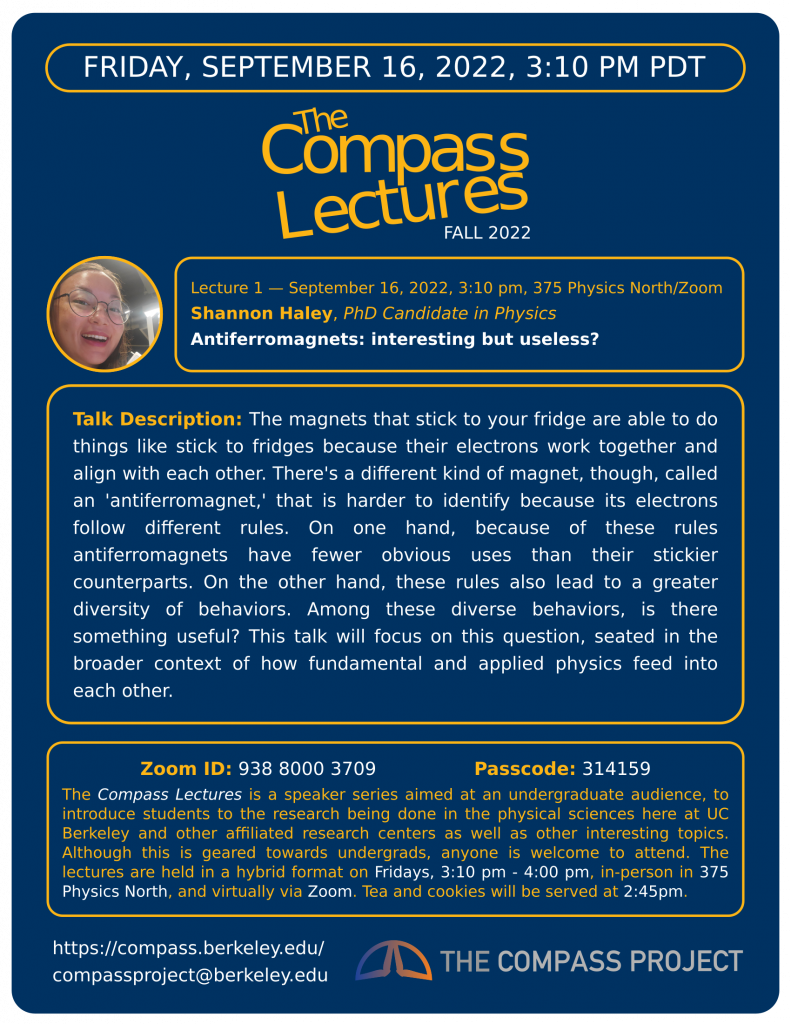
The Song of Rock and Ice – Seems Fuzzy to Me ft. Water World Interiors
Tanja Kovačević, PhD Candidate
Date & Time: Friday, September 23rd, 2022, 3:00pm – 4:00pm
Location: 375 Physics North
Talk Description: Water worlds are exoplanets more massive than Earth that contain a significant amount of water overlaying a rocky mantle and iron core. Characterizing the interactions between water and rock under the pressures and temperatures within water worlds is essential to understanding their structure, formation, and evolution. We studied the dynamics between water and high-pressure MgSiO3, a major silicate phase, and determined the conditions where they form a homogeneous mixture. We find that rock and water become miscible within the interiors of water worlds during their collisional growth, forming a fuzzy, mixed layer and increasing the amount of water incorporated deep within the planet. A mixed layer affects chemical evolution and heat transport through a planet.
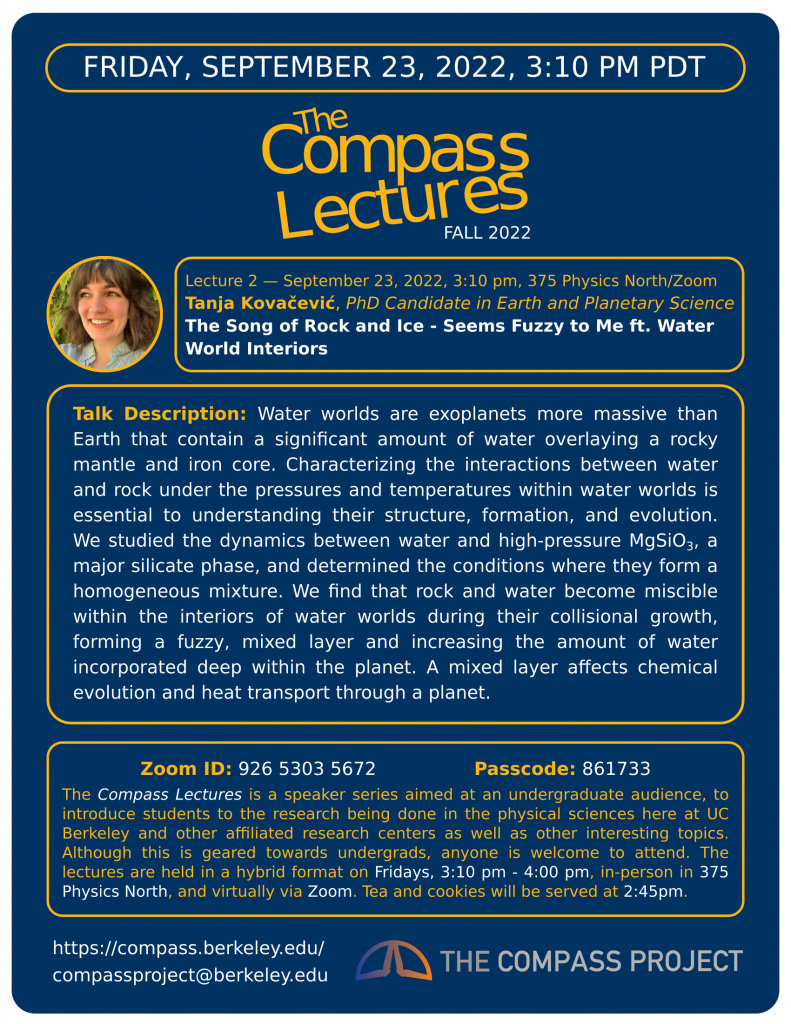
CUORE: The Coldest Cubic Meter in the Known Universe
Kenny Vetter, PhD Candidate
Date & Time: Friday, September 30th, 2022, 3:00pm – 4:00pm
Location: 375 Physics North
Talk Description: Where would you expect to find the coldest cubic meter in the known universe? It is not in some distant empty patch of outer space; it is not even outside of our solar system. It lies under the heart of the Appenine mountains in Italy inside of the CUORE experiment. The CUORE experiment is an ongoing search for rare processes that may help us answer some of the biggest questions in particle physics. In my talk, I will discuss the science goals of the CUORE experiment and the collaboration’s latest results. I will also discuss my work here at Berkeley and how it relates to our overall science mission.
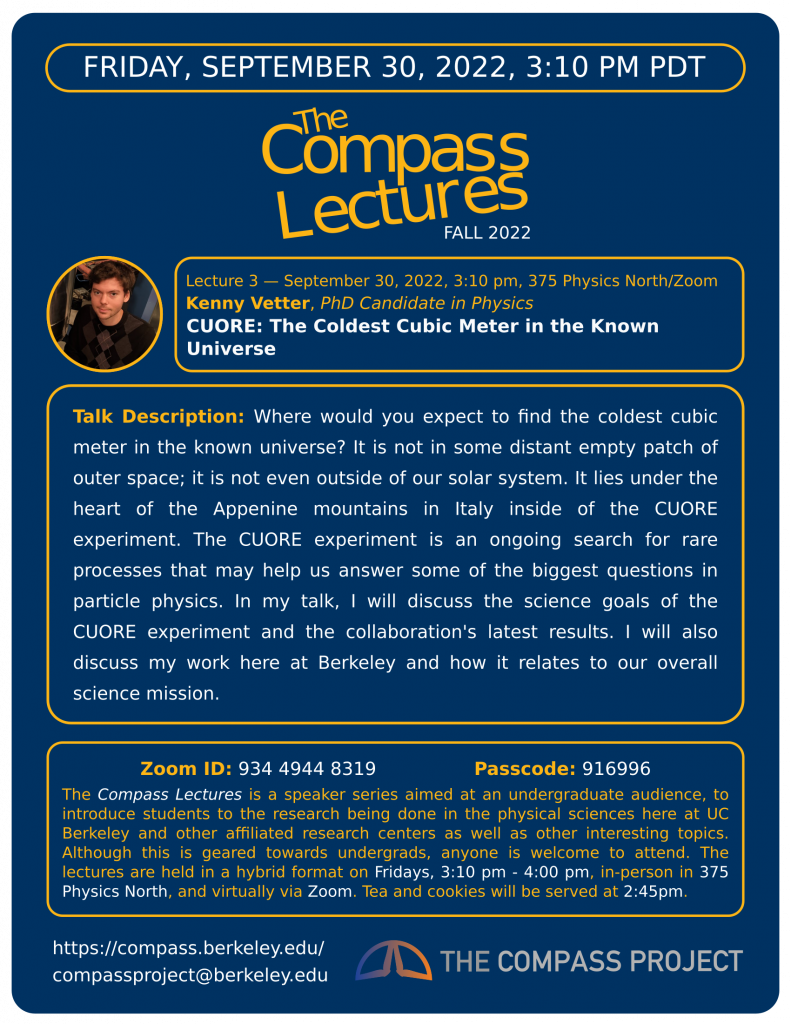
Taking Integrals of Quantum Circuits
Neel Modi, Graduate Student
Date & Time: Friday, October 7th, 2022, 3:00pm – 4:00pm
Location: 375 Physics North
Talk Description: Integration is highly entertaining, especially after throwing the mathematical rigor under the rug. But integrating ordinary functions can get boring. Let’s integrate something else for a change… like a quantum circuit! What does that even mean? We’ll run through a step-by-step evaluation of the so-called “Haar integral” via an elegant and highly diagrammatic method that uses only the fundamental principles of calculus, and we’ll touch on why such a concept is hugely influential in subfields ranging from quantum computing to black hole physics.
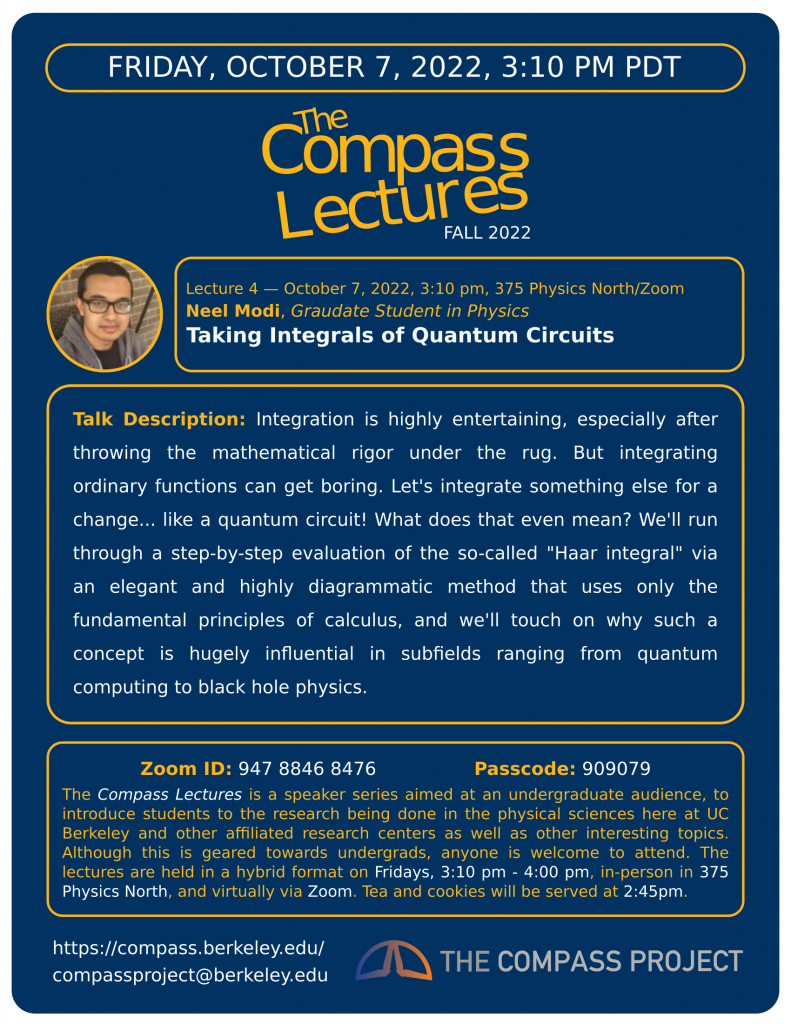
Volumetric interactions between major ruptures and fault zones illuminated by small earthquake properties
Yifang Cheng, Postdoctoral Researcher
Date & Time: Friday, October 14th, 2022, 3:00pm – 4:00pm
Location: 375 Physics North
Talk Description: The interactions between major ruptures and faults have significant impact on their individual properties. Many standard mechanical concepts and models assume that a major rupture is a stick-slip along a single surface in a homogeneous continuum solid. While these simplified models provide important insights to the earthquake and fault mechanics, they contradict to the observed complex earthquake features and may obscure important processes associated with the major ruptures. In this talk, I investigate how the earthquake rupture processes deviate from the simplified models using small earthquake properties and understand the implications from the observed deviations.
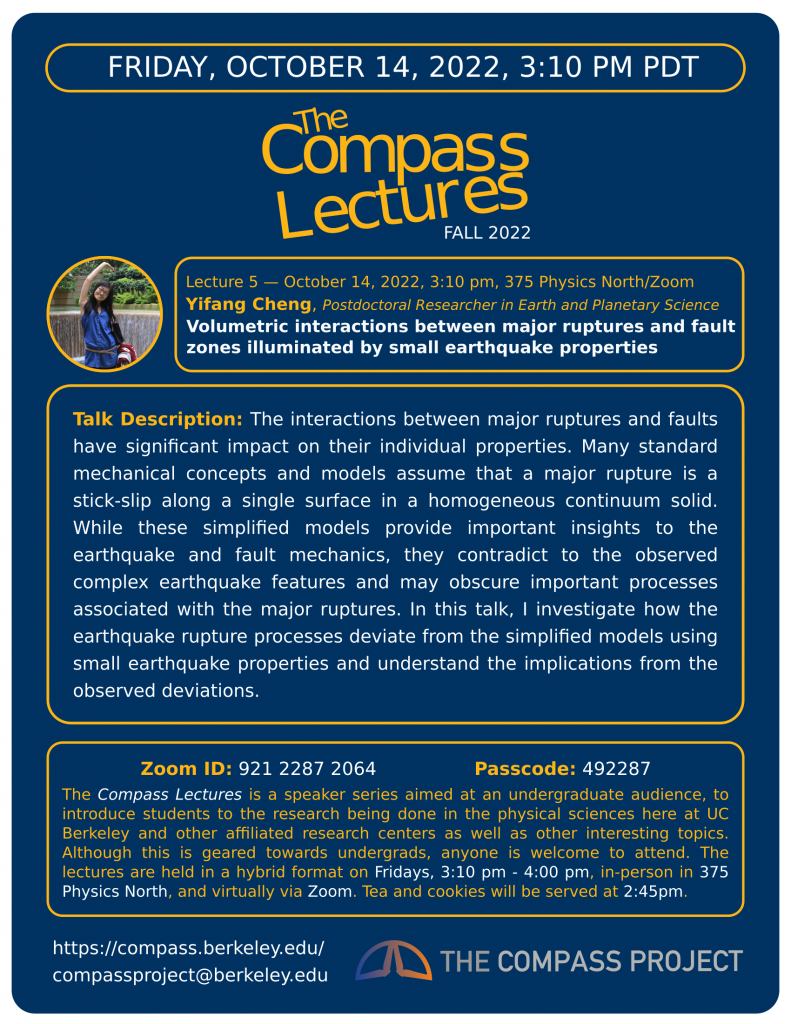
Nanoscience and Nanotechnology
Marc Vila, Postdoctoral Researcher
Date & Time: Friday, October 21st, 2022, 3:00pm – 4:00pm
Location: 375 Physics North
Talk Description: In this talk I will introduce the nano-scale world. By giving examples of all length scales, I will explain just how small a nanometer is. Once that is clear, I will go on explaining why it is interesting to study nanoscience and what can come out of that. Then, I will explain how to observe such a tiny world by means of different types of microscopes and techniques. I will conclude by showing some applications of nanotechnology as well as some of the current state-of-the art topics that are being researched.
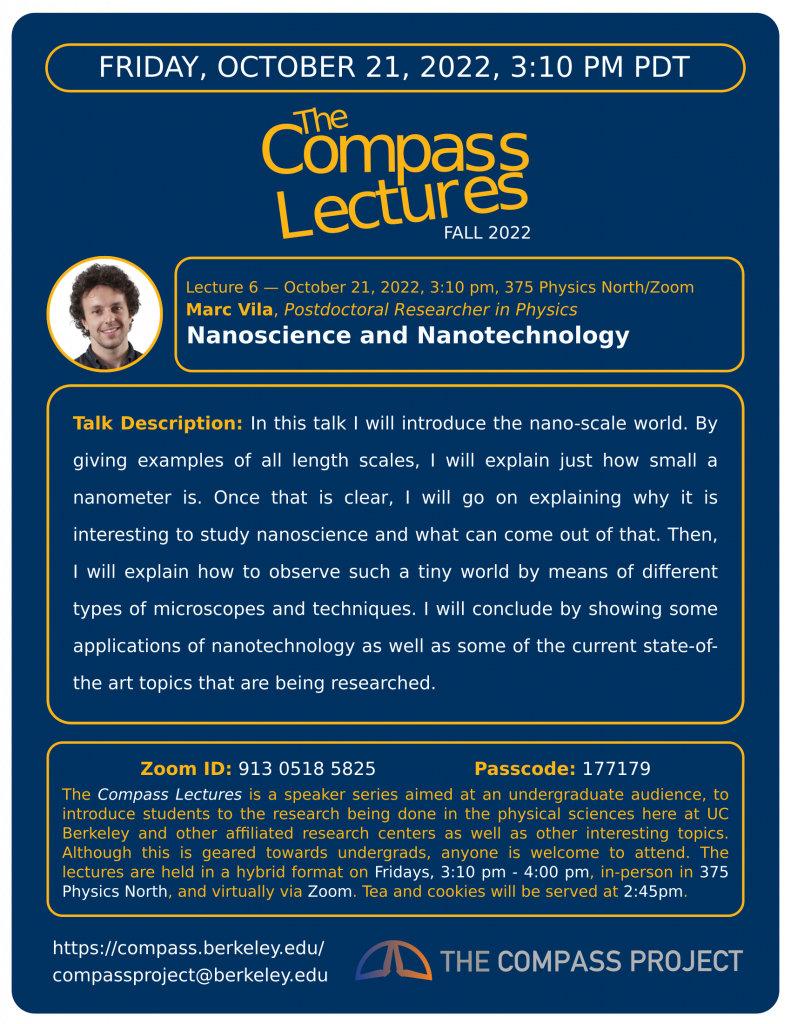
Optical emission from tidal disruption events
Kishore Patra, PhD Candidate
Date & Time: Friday, October 28th, 2022, 3:00pm – 4:00pm
Location: 375 Physics North
Talk Description: When a star gets too close to a black hole, it gets torn apart by enormous tidal forces, resulting in an extremely luminous transient event known as a tidal disruption event (TDE). Theoretically, TDEs were expected to be copious emitters of X-rays, but many TDEs show dominant emission in the visible (optical) wavelength range with little to no X-ray light. Currently, why some TDEs primarily emit visible light remains a big open question. In this talk, I will show how studying polarized light emanating from these events tells us the shape of the post-disruption gas around the black hole, which in turn helps us constrain the source of the TDE’s optical emission.
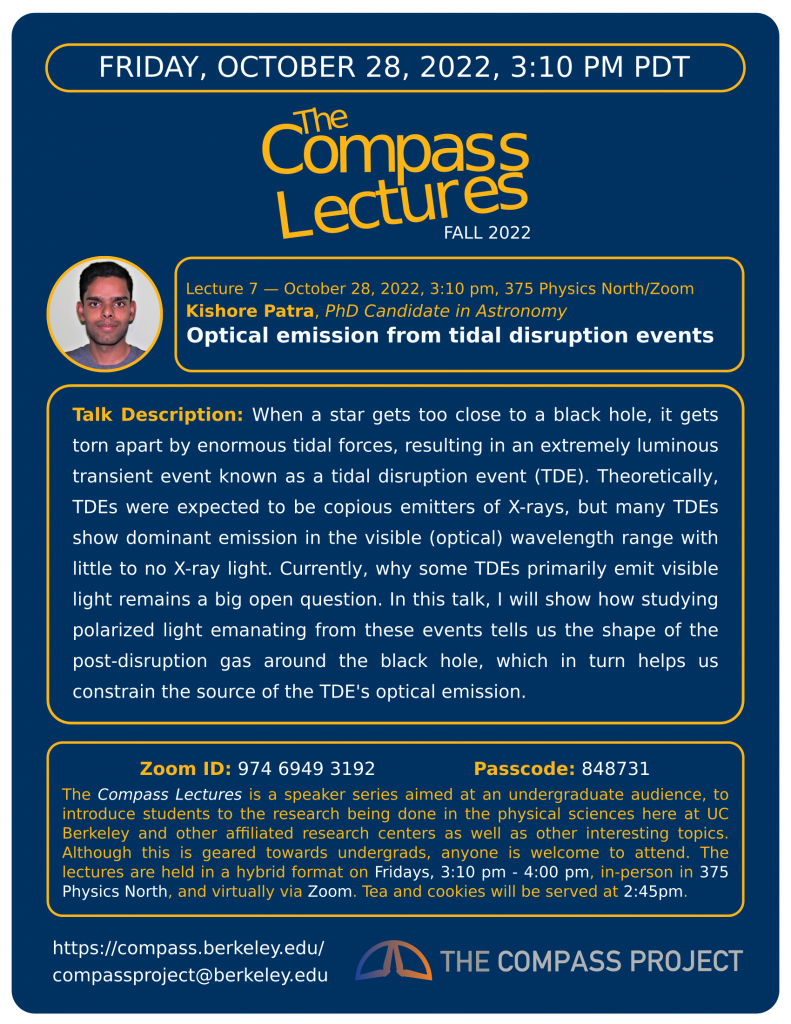
Proving history no one witnessed: How our landscapes formed millions of years ago. And how someone goes from studying rocks to becoming a particle accelerator enthusiast
Michelle Devoe, PhD Candidate
Date & Time: Friday, November 4th, 2022, 3:00pm – 4:00pm
Location: 375 Physics North
Talk Description: Our understanding of Earth is limited by what we can see, what remote tools tell us, and what our models suggest. But how can we actually PROVE that our landscapes formed in the ways we think? No one was there 200 million years ago to confirm. I am developing a methodology to determine the forces that shaped our landscapes by putting real rocks into the synchrotron at LBNL. I also use the synchrotron to explore how the minerals of the deep Earth behave, to help us better understand the forces behind tectonics and deep earthquakes. I’d like to frame the talk around how I ended up at grad school and share an inspiring story about grad school in general.
Talk postponed
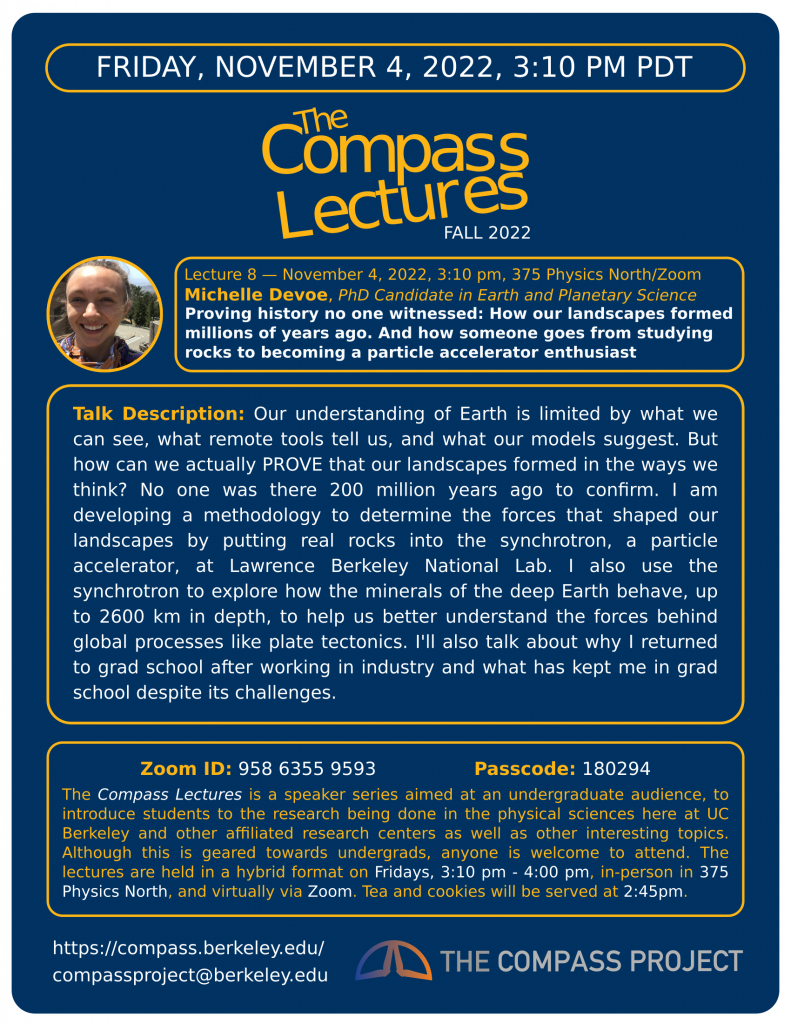
Automated Domain Decomposition for Multi-GPU Electron-Photon Monte Carlo
Vanessa Goss, PhD Candidate
Date & Time: Friday, November 18th, 2022, 3:00pm – 4:00pm
Location: 375 Physics North
Talk Description: My lecture will be about developing Monte Carlo software that models electron-photon interactions for advanced heterogeneous computing architectures. I will describe the Monte Carlo Algorithm and how I modify it for the GPU’s unique architecture. Specifically, I will be describing domain decomposition, a technique that splits a Monte Carlo domain into smaller subdomains and disperses the subdomains across the available processors.
Talk postponed
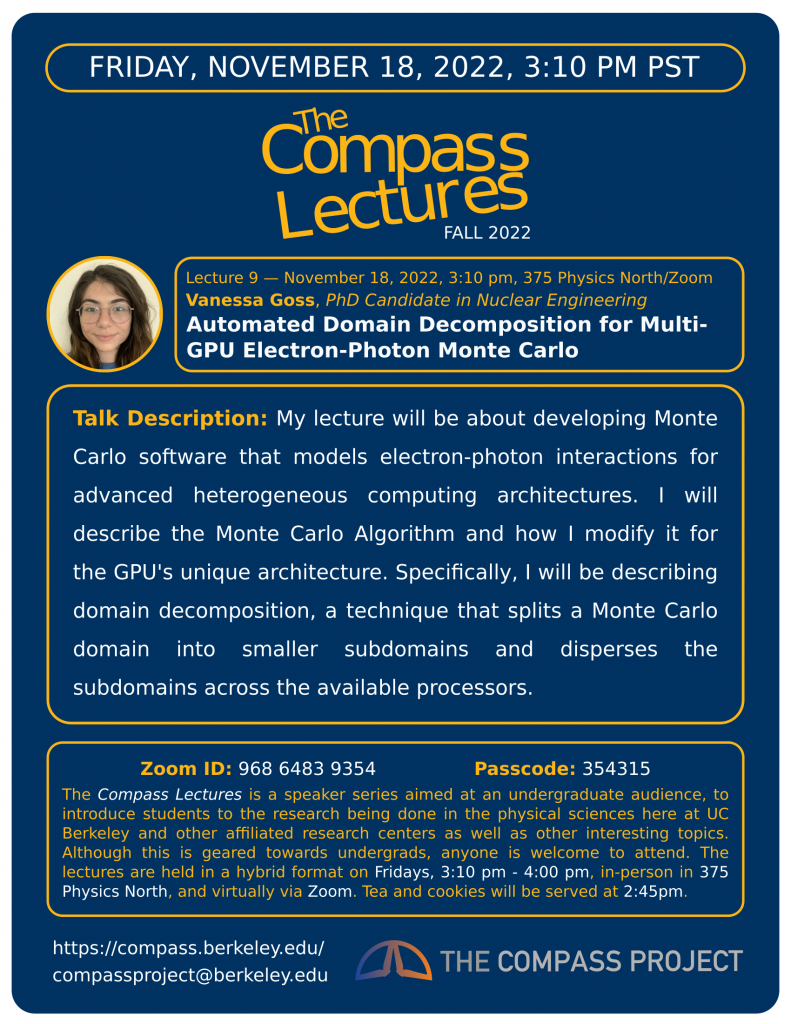
Discovering science inside and outside the lab
Alexander Dasque, Graduate Student
Date & Time: Friday, December 2nd, 2022, 3:00pm – 4:00pm
Location: 375 Physics North
Talk Description: I plan on spending a small bit of time describing how I discovered science “outside” the lab, i.e. how I found out that science was the right career path for me and how I navigated that path as the first person pursuing a career in STEM in my family; and then transitioning into discovering science “inside” the lab, i.e. particular research I’ve worked on. Tentatively I would present on using a spectroscopic technique (Electron Paramagnetic Spectroscopy) to gauge the conformation and mobility of residues on E. coli chemotaxis proteins, highlighting the interdisciplinary approach required to do this (knowledge of chemistry, physics, and biology) and the implications chemotaxis research may have on developing drug targets.
Talk postponed